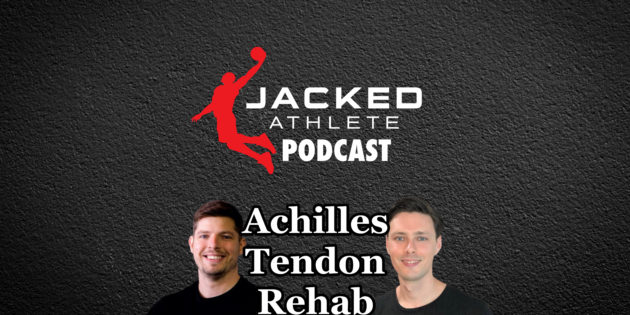https://podcasts.apple.com/us/podcast/jacked-athlete-podcast/id1462537296?i=1000593808623
Personal Achilles Pain
Matt’s Achilles: “I kind of got on top of it with managing how much high velocity stuff I was doing and doing a lot more volume and extensive work.”
David: “My Achilles tendinopathy didn’t come back for the five years after that (exercises to get the heel bone and the mid foot to move).”
The Cause of Achilles Pain
Matt: “Make sure you’re in your competitive spikes, trainers, and playing surface… for some sort of stimulus every week of the year.”
David: “Of course we’re going to look at spikes in load but that’s not everything.”
David: “The ground has gotten very hard in them summer months and that’s where I would see a lot of Achilles and shin splint issues.”
David: “Even something small like that can make such a big difference [skipping rope for 10 minutes].”
When to Intervene
Matt: “There should not be a prolonged period of time where you are not loading that Achilles.”
Matt: “Having in hopping year-long has been my life saver with my athletes.”
Matt: “You can’t hide when you hop. The loading on the Achilles is always there.”
David: “You’ll just end up making yourself neurotic going down that route [trying to prevent Achilles pain]”.
David: “As soon as there’s a ball involved in a sport, the intention is to get better at the sport rather than better at certain movements.”
Calf Raises
Matt: “Moving through plantar and dorsiflexion. That’s how the ankle moves so that’s how we’ll train it. And we can’t see past that.”
Matt: “I’ve found a lot of value in more sweeping action that murdering a typical calf raise.”
David: “Even though I don’t put all my eggs in the calf raise basket, I think some are better than none probably year round.”
David: “They’ve [high level athletes with Achilles tendinopathy] all been told to do a lot of calf raises. They actually have very strong looking calves.”
David: “All the good athletes are hammering calf raises too much or at least sloppily or not with a good plan them.”
David: “If you ask someone even in a seated calf raise, they won’t feel their soleus working.”
David: “As the shin translates forward and as the heel drops down, we should get a tiny bit of pronation at that stage and if not, you’re gonna stretch the life out of the Achilles and that doesn’t feel so good.”
David: “Pogos in a zig zag or sideways, that sweeping through the ankle, that’s magic for me.”
Twisted Achilles
David: “If you don’t know the anatomy that makes up these tendons, if you look at the bones and what they’re doing. No relative motion at the knee joint really (patellar tendon). Whereas there is a decent amount of movement at the ankle (Achilles tendon) in these max propulsive positions.”
David: “A positive shin angle… driving from a slightly pronated position… and that’s what lights the soleus up a ton… that’s where I do most of my bent-knee work, it’s not in a bent-knee calf raise, it’s actually teaching people to drive their foot as hard through the floor as they can.”
Matt on someone with PT who develops AT: “Someone that potentially might have dropped their hips in order to feel as if they’re getting positive shin angle and then everything gets paddled from the ankle and you get this overuse on the Achilles.”
Matt: “Look at the whether a drop in the hips is overworking the lower leg.”
Matt: “The knee joint… because it’s in the middle, the work that happens above it and below it is so much more difficult to figure out.”
Matt: “When you’re doing it really rudimentary, you’re just getting great movement through the ankle joint and teaching the body to be happy with anticipating the ground.”
Matt: “A worsening effect through the tendon… when you’re scared to hit the ground, that often freezes up the bones that need to move freely.”
Bridging the Gap
1:05
Matt: “The loading mechanism and time under tension of the Achilles is always the exact same [just bridging the gap with stationary pogo hops].”
Matt: “You’re almost better in saying, past week one, we don’t do anything on the spot.”
Matt on store-and-release: “They don’t have to be plyometrics… they can just be landing and takeoffs… and they can be less violent, less dynamic.”
Matt: “Realistically, 99% of us move in a horizontal manner when we move in sport and there are very few moments where we need up-and-down movements.”
A Locked Up Foot
David: “1) a really high arch, 2) the calcaneus is posterior tilted, 3) first metatarsal is plantar flexed down (it’s pushing straight down into the floor)…. the foot is not going to unlock and that person is not going to get into the mid foot.”
Matt: “People hide so much more in supination with bilateral movement as opposed to unilateral movement.”
Matt: “Chip away, hope that these things will eventually figure themselves out… and certain days it just unfolds.”
David: “The first thing you should think about for an Achilles is what’s not sharing the load… and I’m not gonna go up and talk about glute strength because my foot is gonna hit the floor way before… the glute needs time to produce force… the foot can disperse force immediately.”
David: “For a lot of people, getting that foot and ankle moving well, it just seems to work really well.”
David’s Website: https://davidgreyrehab.com
David’s Instagram: https://www.instagram.com/davidgreyrehab/?hl=en
Matt’s Website: https://www.plusplyos.com
Matt’s Instagram: https://www.instagram.com/mcinneswatson/?hl=en



